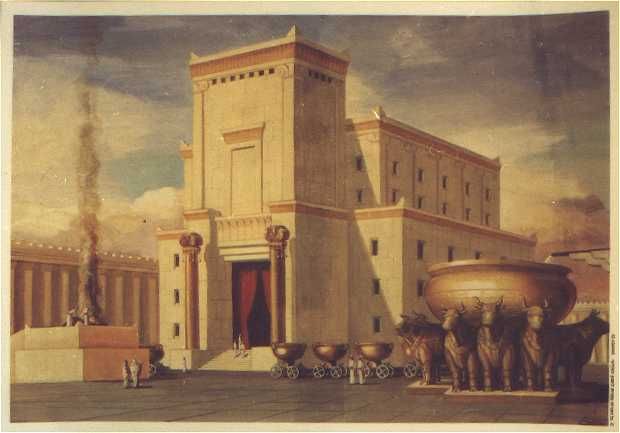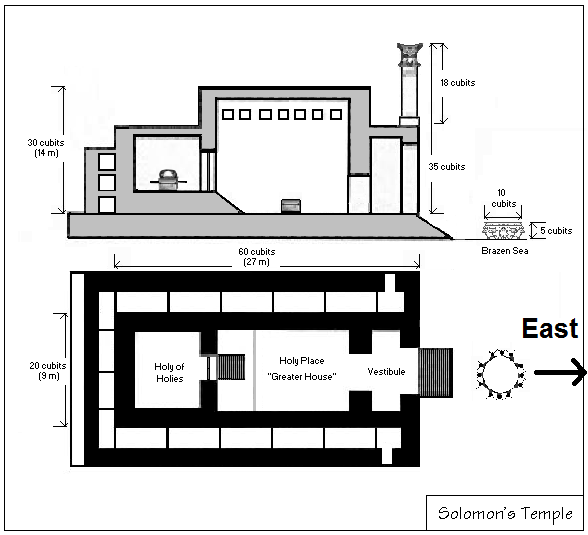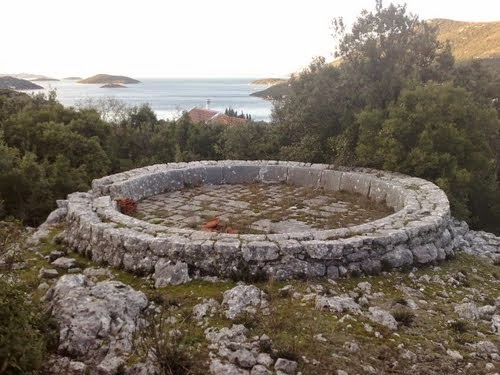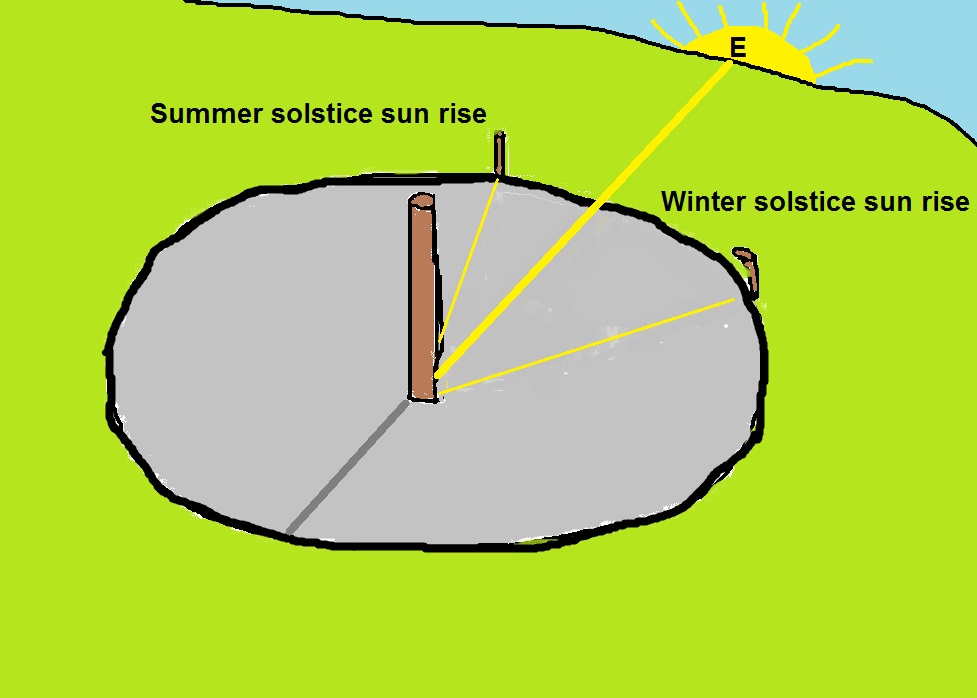This is an artist interpretation of the first temple based on the available descriptions. Boaz and Jachin are two dark free standing pillars located on the porch on both sides of the entrance.
Jest to artystyczna interpretacja pierwszej świątyni na podstawie dostępnych opisów. Boaz i Jachin to dwa ciemne, wolnostojące filary umieszczone na ganku po obu stronach wejścia.
The entrance and the porch was located on the eastern side of the temple. This means that the temple entrance and Boaz and Jachin faced the rising sun.
Wejście i kruchtę umieszczono po wschodniej stronie świątyni. Oznacza to, że wejście do świątyni oraz Boaz i Jakin były zwrócone w stronę wschodzącego słońca.
Why is this important for understanding of the meaning of Boaz and Jachin?
Dlaczego jest to ważne dla zrozumienia znaczenia słów Boaz i Jakin?
In the 2 Chronicles 3:1 we are told that „Solomon built the temple of the LORD in Jerusalem on Mount Moriah, where the LORD had appeared to his father David. It was on the threshing floor of Araunah the Jebusite, the place provided by David…”
W 2 Kronikach 3: 1 czytamy, że „Salomon zbudował świątynię Pańską w Jerozolimie na górze Moria, gdzie Pan ukazał się jego ojcu Dawidowi. Było to klepisko Arauny Jebusyty, miejsce ustanowione przez Dawida…”
So the first temple was built on a threshing floor. A threshing floor probably like this one from Croatia. Threshing floors are platforms where grain seeds were separated from chaff by trampling.
Tak więc pierwsza świątynia została zbudowana na klepisku. Było to boisko chyba takie jak to z Chorwacji. Klepiska to platformy, na których ziarna zbóż były oddzielane od plew przez deptanie (to pierwotne młocarnie).
Once the threshing floor is constructed it can be used for both threshing and as a solar observatory. What you are actually observing is the shadow made by the central stake or a standing stone. At the sunrise and sunset the shadow will be long enough to cut the circle at the oposite end. This is extremely precise way of marking the sunrise point.
Po zbudowaniu klepisko może być wykorzystywane zarówno do omłotu, jak i jako obserwatorium słoneczne. To, co faktycznie obserwujesz, to cień rzucany przez centralny palik lub stojący kamień. O wschodzie i zachodzie słońca cień będzie wystarczająco długi, aby przeciąć okrąg na przeciwległym końcu. Jest to niezwykle precyzyjny sposób wyznaczania punktu wschodu słońca.
In 1950, Serbian ethnographer Nenad Jankovi
ć published a book on folk astronomy called „Astronomija u predanjima, obicajima i umotvorinama Srba” (Astronomy in legends, customs and oral and written tradition of the Serbs). In it he expressed his great surprise at the ability of ordinary illiterate peasants to tell exact date and time without calendars and clocks. Professor Jankovic states that one of the main instruments used for these calendar and time calculations was the threshing floor. By looking at the shadow cast by the stožer, the central pole at sunrise, they were able to tell the date. And by looking at the shadow cast by the stožer, the central pole during the day they were able to tell the time. Threshing floor is a universal solar observatory, which at the same time can tell the date and the time. The main parts of this solar observatory were solar circle and its center, solar pole, sto
žer. Or if viewed from above, from heaven, the way Sun God would see it, a circle and a dot representing its center, solar pole, sto
žer. This is the symbol found all over the world and in Egypt it was the symbol of the sun, Ra. The below symbol is usually interpreted to mean sun disc, but I believe that it actually means sun circle, threshing floor and sun cycle observed from the threshing floor.W 1950 r. Serbski etnograf Nenad Janković opublikował książkę o astronomii ludowej zatytułowaną „Astronomija u predanjima, obicajima i umotvorinama Srba” (Astronomia w legendach, zwyczajach oraz ustnej i pisemnej tradycji Serbów). Wyraził w nim swoje wielkie zdziwienie zdolnością zwykłych niepiśmiennych chłopów do określania dokładnej daty i godziny bez kalendarzy i zegarów. Profesor Jankovic twierdzi, że jednym z głównych instrumentów wykorzystywanych do tych obliczeń kalendarza i czasu było klepisko. Patrząc na cień rzucany przez stožer, centralny biegun/słup o wschodzie słońca, chłopi byli w stanie określić datę. A patrząc na cień rzucany przez stožer, centralny biegun/słup w ciągu dnia, byli w stanie określić czas. Klepisko to uniwersalne obserwatorium słoneczne, które jednocześnie potrafi określić datę i godzinę. Głównymi częściami tego obserwatorium słonecznego były koło słoneczne i jego środek, biegun/słup słoneczny, stožer. Lub patrząc z góry, z nieba, tak, jak widziałby to Bóg Słońca, okrąg i kropka reprezentujące jego środek, biegun słoneczny, stožer. Jest to symbol występujący na całym świecie, a w Egipcie był to symbol słońca Ra. Poniższy symbol jest zwykle interpretowany jako dysk słoneczny, ale uważam, że w rzeczywistości oznacza on krąg słoneczny, klepisko i cykl słońca obserwowany z klepiska.
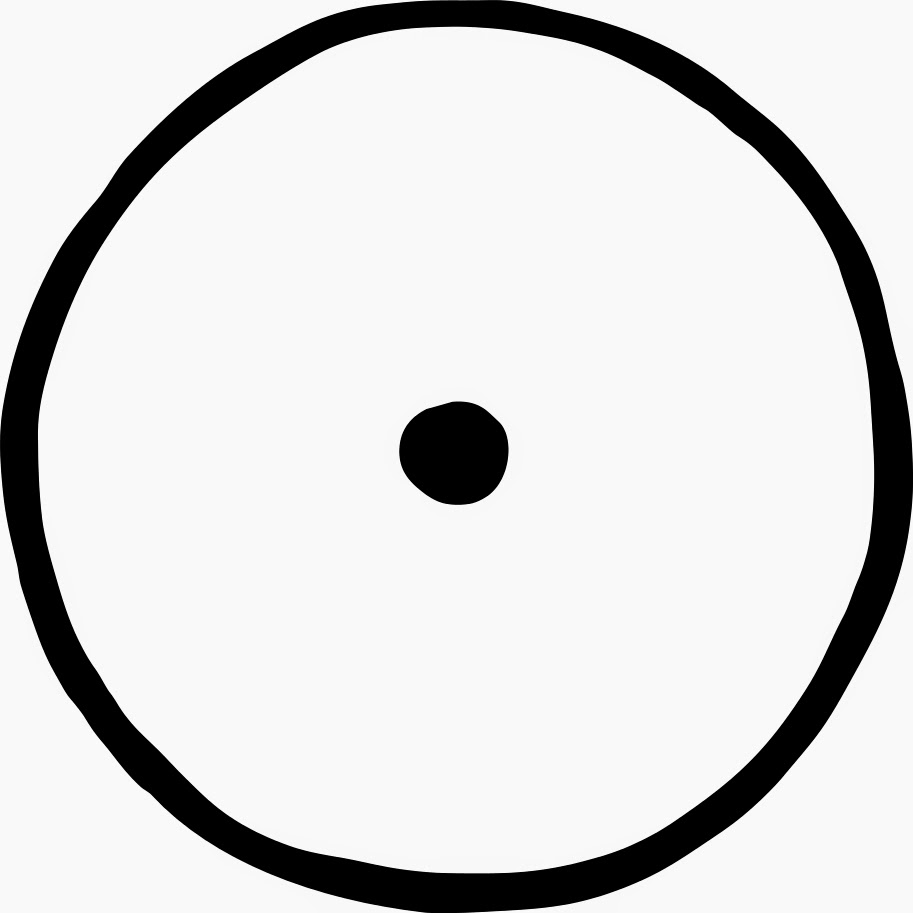
Greeks called the central
solar pole, sto
žer of the sundial „
gnomon” meaning the one which knows. This was because the central stake „new” the time and date.
Grecy nazywali centralny biegun/słup słoneczny, stožer zegara słonecznego „gnomon”, czyli ten, który wie. Stało się tak, ponieważ centralny palik „mówił”/”podawał” / „znał” czas i datę.
According to ethnographic research from the Balkan mountains conducted in the 19th century, threshing floor was the place where all the village meetings, celebrations and ceremonies took place.The ethnographers say that this is because threshing floors were the only flat smooth surfaces big enough to accommodate many people. But was this the only reason? Were threshing floors places where village meetings, celebrations and ceremonies took place because they were considered to be the sacred ground, the place where god lived on earth? I believe so.
Według badań etnograficznych z gór bałkańskich przeprowadzonych w XIX wieku, klepisko było miejscem, gdzie odbywały się wszystkie wiejskie spotkania, uroczystości i ceremonie, zbory wielu ludzi. Ale czy to był jedyny powód? Czy klepiska były miejscami wiejskich zebrań, uroczystości i obrzędów, bo uważano je za świętą ziemię, miejsce zamieszkiwania boga na ziemi? Tak mi się wydaje.
Were threshing floors the mysterious „sacred high places”? I believe so too.
Czy klepiska były tajemniczymi „świętymi wyniesieniami”? Ja też tak uważam.
Więcej o klepiskach i ich roli w uprawianiu kultu słonecznego przeczytasz w moim poście „Bogovo gumno – boskie klepisko”.
In my post „
Calendar” I explained why the ancient solar observatories were built and how they were used. The ancient solar observatories were built in order to determine the exact moment of the winter and (or) summer solstice. If you know one or both of these two points on the yearly solar circle, you can create fixed and repeatable lunisolar calendar which is necessary for in order to determine the exact timing of vegetative events during the solar year.
W moim poście „Kalendarz” wyjaśniłem po co budowano starożytne obserwatoria słoneczne i jak je wykorzystywano. Starożytne obserwatoria słoneczne zostały zbudowane w celu określenia dokładnego momentu przesilenia zimowego i (lub) letniego. Jeśli znasz jeden lub oba te dwa punkty na rocznym kręgu słonecznym, możesz stworzyć stały i powtarzalny kalendarz księżycowo-słoneczny, który jest niezbędny do określenia dokładnego czasu wydarzeń wegetacyjnych w ciągu roku słonecznego.
So how do you determine the exact moment of the winter and (or) summer solstice?
Jak więc określić dokładny moment przesilenia zimowego i (lub) letniego?
You find a clear flat piece of high ground from which you can observe sunrises and sunsets. The observatory. You stick a pole into the ground to mark the observation spot. Then as the year passes, every morning and every evening you stand next to the observation pole and observe sunrise and sunset. As you are observing the sunrises and sunsets, you notice that the point where sun rises is not the same as the point where sun sets. The sun rises on the left side of the horizon, travels across the sky from left to right and sets at the opposite right side of the horizon. As days pass you realize that the point where the sun rises moves along the horizon. So does the point where the sun sets. You notice that the sunrise point moves during the spring further and further to the left and the sunset point further and further to the right. So the sun needs to travel longer across the sky and the day is longer and longer and hotter and hotter. Then at some point during the summer the sunrise and sunset points start moving in the opposite direction. The sunrise point starts moving to the right and sunset point starts moving to the left. They get closer and closer to each other, so the sun has to travel shorter distance between the sunrise and sunset and the day is shorter and shorter and colder and colder.
Znajdujesz czysty płaski kawałek wzniesienia, z którego możesz obserwować wschody i zachody słońca. Obserwatorium. Wbijasz tyczkę w ziemię, aby zaznaczyć miejsce obserwacji. Następnie, w miarę upływu roku, każdego ranka i każdego wieczoru stoisz obok słupa widokowego i obserwujesz wschód i zachód słońca. Obserwując wschody i zachody słońca, zauważasz, że punkt, w którym słońce wschodzi, nie jest tym samym, co punkt, w którym zachodzi. Słońce wschodzi po lewej stronie horyzontu, wędruje po niebie od lewej do prawej i zachodzi po przeciwnej, prawej stronie horyzontu. W miarę upływu dni zdajesz sobie sprawę, że punkt, w którym wschodzi słońce, przesuwa się wzdłuż horyzontu. Podobnie punkt, w którym zachodzi słońce. Zauważasz, że punkt wschodu słońca przesuwa się wiosną coraz bardziej w lewo, a punkt zachodu słońca coraz bardziej w prawo. Więc słońce musi dłużej podróżować po niebie, a dzień jest coraz dłuższy i coraz gorętszy. W pewnym momencie latem punkty wschodu i zachodu słońca zaczynają przesuwać się w przeciwnym kierunku. Punkt wschodu zaczyna przesuwać się w prawo, a punkt zachodu słońca w lewo. Zbliżają się do siebie coraz bardziej, przez co słońce musi przebyć coraz krótszą drogę między wschodem a zachodem słońca, a dzień jest coraz krótszy i coraz zimniejszy.
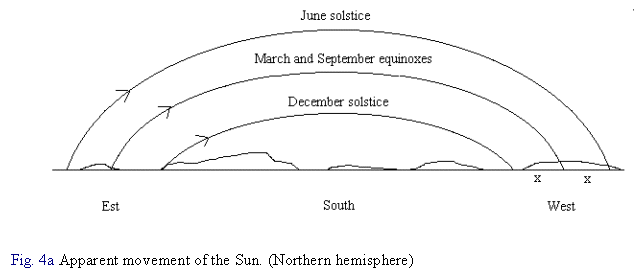
This is extremely important observation if you depend on solar vegetative cycle for your survival. If the length and heat of the day depends on the position of the sunrise and sunset points, then determining how they move becomes imperative. You know that the days when the sunrise and sunset points change the direction of their movements, fall in the middle of the coldest and hottest part of the year. You are of course more interested in the turning point which falls in the middle of the cold dark part of the year. You want to know if, and this was for our ancestors very real IF, and when the sunrise and sunset points will start moving further and further away from each other, because that will mean that the days will start getting longer and hotter again. So you start observing the the horizon and you try to remember where the sun rose yesterday in order to compare it with the sunrise position today. But that is difficult and imprecise. It would be much better if you could mark the points of sunrise every day in some way and then observe the relative position of the sunrise points to the marks. So you decide to use stake, pole as marker. But it is difficult to mark the exact point of sunrise if the horizon is uneven. It would be much easier if the horizon is horizontal, smooth and elevated all around you so that the observation and marking of the sunrise points becomes more precise. So you decide to create an artificial horizontal smooth horizon which will mask the real horizon. You take a long enough rope, tie it to the observation pole and then walk around the observation pole. As you walk you mark a circle with the center in the observation pole.
Jest to niezwykle ważna obserwacja dla twojego przetrwania, jeśli polegasz na słonecznym cyklu wegetatywnym. Jeśli długość i upał dnia zależą od położenia punktów wschodu i zachodu słońca, określenie, w jaki sposób się poruszają, staje się koniecznością. Wiesz, że dni, w których punkty wschodu i zachodu słońca zmieniają kierunek swojego ruchu, przypadają na środek najzimniejszej i najgorętszej części roku. Oczywiście bardziej interesuje Cię punkt zwrotny, który przypada na środek zimnej, ciemnej pory roku. Chcesz wiedzieć, czy, a dla naszych przodków było to bardzo realne JEŚLI, i kiedy punkty wschodu i zachodu słońca zaczną się coraz bardziej oddalać od siebie, bo to będzie oznaczać, że dni znowu zaczną się wydłużać i będą gorętsze. Zaczynasz więc obserwować horyzont i próbujesz sobie przypomnieć, gdzie wczoraj wzeszło słońce, aby porównać to z pozycją dzisiejszego wschodu. Ale to trudne i nieprecyzyjne. Byłoby znacznie lepiej, gdybyś codziennie w jakiś sposób zaznaczał punkty wschodu słońca, a następnie obserwował względne położenie punktów wschodu słońca względem tych znaków. Decydujesz się więc użyć kołka, tyczki jako znacznika. Ale trudno jest wyznaczyć dokładny punkt wschodu słońca, jeśli horyzont jest nierówny. Byłoby znacznie łatwiej, gdyby horyzont był poziomy, gładki i wzniesiony wokół ciebie, dzięki czemu obserwacja i oznaczanie punktów wschodu słońca stanie się bardziej precyzyjne. Postanawiasz więc stworzyć sztuczny poziomy gładki horyzont, który zamaskuje prawdziwy horyzont. Bierzesz odpowiednio długą linę, przywiązujesz ją do słupa obserwacyjnego, a następnie obchodzisz słup obserwacyjny. Idąc, zaznaczasz okrąg ze środkiem na tyczce obserwacyjnej.

You then dig a circular trench along the circle and pile up the the dug out earth on the edge of the circle to form the bank. You build a henge like this original earthen henge in Stonehenge. You can read my article about henges
here.
Następnie wykopujesz okrągły rów wzdłuż okręgu i układasz wykopaną ziemię na krawędzi okręgu, aby utworzyć brzeg. Budujesz krąg jak ten oryginalny ziemny krąg w Stonehenge. Możesz przeczytać mój artykuł o Stonehenge tutaj.

Now when the sun rises it will be easy to mark the exact spot of the sunrise with a stake stuck into the elevated earthen bank. Every morning and evening you observe the new position of the sunrise point. If the sun does not rise at the point marked with the yesterday’s stake, you move the stake to mark the new position of the sunrise. Then one day in the middle of the winter, the movement of the sunrise point will stop. The sun will rise at the same position behind the yesterday’s sunrise stake. That day is the winter turning point, the winter solstice, the shortest day of the year. You mark this point with the permanent taller stake. So when the sun again rises behind this tall sunrise stake you will know that the winter turning point, the winter solstice, the shortest day has arrived again. You do the same for the day when the sun rises twice behind the same stake in the summer. That day is the summer turning point, the summer solstice, the longest day of the year. You mark this point with the permanent taller stake too. So when the sun again rises behind this tall sunrise stake you will know that the summer turning point, the summer solstice, the longest day has arrived again.
Teraz, gdy wzejdzie słońce, łatwo będzie zaznaczyć dokładne miejsce wschodu za pomocą kołka wbitego w uniesiony ziemny brzeg. Codziennie rano i wieczorem obserwujesz nową pozycję punktu wschodu słońca. Jeśli słońce nie wzejdzie w punkcie zaznaczonym wczorajszym kołkiem, przesuwasz kołek, aby zaznaczyć nową pozycję wschodu słońca. Pewnego dnia w środku zimy ruch punktu wschodu słońca ustanie. Słońce wzejdzie w tym samym miejscu za wczorajszym palikiem wschodu słońca. Ten dzień jest punktem zwrotnym zimy, przesileniem zimowym, najkrótszym dniem w roku. Zaznaczasz ten punkt stałym wyższym palikiem. Więc kiedy słońce ponownie wzejdzie za tym wysokim słupem wschodu słońca, będziesz wiedział, że punkt zwrotny zimy, przesilenie zimowe, najkrótszy dzień ponownie nadszedł. To samo robisz w dniu, w którym latem słońce wschodzi dwa razy za tym samym palikiem. Ten dzień to letni punkt zwrotny, letnie przesilenie, najdłuższy dzień w roku. Zaznaczasz ten punkt również stałym wyższym palikiem. Kiedy więc słońce ponownie wzejdzie za tym wysokim słupem wschodu słońca, będziesz wiedział, że letni punkt zwrotny, przesilenie letnie, najdłuższy dzień ponownie nadszedł.
Do you see how much the above henge looks like a threshing floor? If you were using threshing floor as a solar observatory, and if you marked the solstice points with two sticks your threshing floor would look like this:
Czy widzisz, jak bardzo powyższy krąg przypomina klepisko? Gdybyś używał klepiska jako obserwatorium słonecznego i zaznaczyłbyś punkty przesilenia dwoma kijami, klepisko wyglądałoby tak:
Now if you know the position of the winter and summer solstice, the three stakes, the central stake, and the two solstice stakes can be used to determine the position of the true east.
Teraz, jeśli znasz położenie przesilenia zimowego i letniego, trzy paliki, środkowy palik i dwa paliki przesilenia mogą być użyte do określenia położenia prawdziwego wschodu.
Which could be very useful if, for instance, you were building a temple that you wanted to orient towards the east. By the way do you know that to orient literally means to turn east?
Co może być bardzo przydatne, jeśli np. budujesz świątynię, którą chcesz skierować na wschód. A propos, czy wiesz, że orientować się dosłownie znaczy skręcić na wschód?
So we have two sticks, stuck at the edge of the threshing floor, the ancient solar observatory, on top of which the first temple was built. Marking the sun’s turning points on the horizon, one for winter solstice, the other for summer solstice. Between is east, the area of the horizon where sun rises. Two sticks mark the entrance into the house of Sun, the house of God. The sun gate…Right in the middle of this due east, the direction towards which the ancient Hebrew temple door was oriented, to welcome God (sun) in… Hence two pillars, Boaz and Joktan…
Mamy więc dwa kije, wbite w krawędź klepiska, starożytnego obserwatorium słonecznego, na szczycie którego zbudowano pierwszą świątynię. Oznaczanie punktów zwrotnych słońca na horyzoncie, jeden na przesilenie zimowe, drugi na przesilenie letnie. Pomiędzy jest wschód, obszar horyzontu, gdzie wschodzi słońce. Dwa patyki oznaczają wejście do domu Słońca, domu Boga. Brama słońca… W samym środku tego kierunku wschodniego, w kierunku, w którym skierowane były drzwi starożytnej hebrajskiej świątyni, aby powitać Boga (słońce) w… Stąd dwa filary, Boaz i Joktan (Jakin CB)…
Knowing this, I don’t think that the decision to build the first temple on a threshing floor was accidental. Threshing floors and other solar observatories were holy places for sun worshipers. And if the sun worshipers wanted to build a temple dedicated to the sun god, then building it on top of a threshing floor and orienting it towards the east and marking the points of the two solstices with two prominent free standing columns would be very logical thing to do indeed.
Wiedząc o tym, nie sądzę, aby decyzja o budowie pierwszej świątyni na klepisku była przypadkowa. Klepiska i inne obserwatoria słoneczne były świętymi miejscami dla czcicieli słońca. A jeśli czciciele słońca chcieli zbudować świątynię poświęconą bogu słońca, to zbudowanie jej na szczycie gdzie było klepisko i skierowanie jej na wschód oraz zaznaczenie punktów dwóch przesileń dwoma wydatnymi wolno stojącymi kolumnami byłoby bardzo logiczne i należałoby to zrobić rzeczywiście.
But wait, am I saying that the first temple was dedicated to the sun god? Is there any indication that that this could have been the case? Actually yes…But more about this in my next post.
Ale zaraz, czy ja mówię, że pierwsza świątynia była poświęcona bogu słońca? Czy coś wskazuje na to, że tak mogło być? Właściwie tak… Ale o tym więcej w następnym poście.


